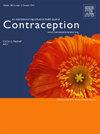DIFFERENCES IN ABORTION FUND MESSAGING IN ENGLISH AND SPANISH: A SOCIAL MEDIA ANALYSIS
IF 2.3
2区 医学
Q1 OBSTETRICS & GYNECOLOGY
引用次数: 0
Abstract
Objectives
For many abortion seekers in the US, abortion funds are their only source of timely information about abortion access. However, this information is frequently only available in English. Approximately 20% of the US population speaks a language other than English at home, and non-English-speaking abortion seekers face even greater barriers in accessing information about abortion. This study sought to understand differences in how abortion funds present information about abortion across languages by analyzing English and Spanish social media posts published by abortion funds.
Methods
Twitter, Facebook, and Instagram posts published by the 95 abortion funds affiliated with the National Network of Abortion Funds between June 2022 and January 2025 were collected for large-scale linguistic analysis. Some 10% of posts were randomly sampled for qualitative thematic analysis through an inductive coding process guided by the conceptual framework, “Trajectories of Women’s Abortion-Related Care” by two investigators.
Results
Some 10,118 total social media posts were found (10,051 English, 66 Spanish, and 1 Portuguese). Only 16 abortion funds (17%) published social media posts in non-English languages. Linguistic analysis showed 55% of English social media posts referenced sexual health and well-being compared to only 13% of Spanish posts. Thematic analysis revealed that English posts primarily described the sociopolitical landscape of abortion and calls for fundraising, while Spanish posts primarily described access to services at specific abortion funds.
Conclusions
Most abortion funds published posts in English only, and messaging varied greatly by language. Future work should explore hidden assumptions that may drive this difference in information presentation.
堕胎基金英语和西班牙语信息传递的差异:一项社交媒体分析
目的对美国许多寻求堕胎的人来说,堕胎基金是他们获得堕胎及时信息的唯一来源。然而,这些信息通常只有英文版本。大约20%的美国人在家说英语以外的语言,非英语国家的堕胎寻求者在获取堕胎信息时面临更大的障碍。这项研究试图通过分析堕胎基金发布的英语和西班牙语社交媒体帖子,了解堕胎基金如何跨语言呈现堕胎信息的差异。方法收集全国堕胎基金网络(National Network of abortion funds)旗下95家堕胎基金在2022年6月至2025年1月期间发布的twitter、Facebook和Instagram帖子进行大规模语言分析。随机抽取约10%的帖子,由两名调查人员通过归纳编码过程,在概念框架“妇女堕胎相关护理轨迹”的指导下进行定性专题分析。结果共发现10118篇社交媒体帖子(英语10051篇,西班牙语66篇,葡萄牙语1篇)。只有16家堕胎基金(17%)在社交媒体上发布了非英语的帖子。语言分析显示,55%的英语社交媒体帖子提到性健康和幸福,而西班牙语帖子中只有13%提到性健康和幸福。专题分析显示,英语帖子主要描述了堕胎的社会政治状况和筹款呼吁,而西班牙语帖子主要描述了在特定堕胎基金获得服务的情况。结论大多数堕胎基金只发布英文帖子,不同语言的信息差异很大。未来的工作应该探索可能导致信息呈现差异的隐藏假设。
本文章由计算机程序翻译,如有差异,请以英文原文为准。
求助全文
约1分钟内获得全文
求助全文
来源期刊

Contraception
医学-妇产科学
CiteScore
4.70
自引率
17.20%
发文量
211
审稿时长
69 days
期刊介绍:
Contraception has an open access mirror journal Contraception: X, sharing the same aims and scope, editorial team, submission system and rigorous peer review.
The journal Contraception wishes to advance reproductive health through the rapid publication of the best and most interesting new scholarship regarding contraception and related fields such as abortion. The journal welcomes manuscripts from investigators working in the laboratory, clinical and social sciences, as well as public health and health professions education.
 求助内容:
求助内容: 应助结果提醒方式:
应助结果提醒方式:


